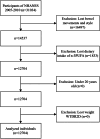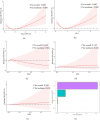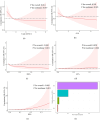Dose-Dependent Effects of Dietary n-3 Fatty Acids on Bowel Health: Plant-Sourced ALA Modulates Diarrhea Risk While Marine-Sourced DHA/EPA Prevent Constipation in NHANES 2005-2010
- PMID: 40772019
- PMCID: PMC12326190
- DOI: 10.1002/fsn3.70769
Dose-Dependent Effects of Dietary n-3 Fatty Acids on Bowel Health: Plant-Sourced ALA Modulates Diarrhea Risk While Marine-Sourced DHA/EPA Prevent Constipation in NHANES 2005-2010
Abstract
Although omega-3 polyunsaturated fatty acid (n-3PUFA) is generally considered to have positive effects on bowel health, the understanding of the impacts of n-3PUFA on bowel function is limited. This study aimed to deeply investigate the association between n-3PUFA, diarrhea, and constipation and discussed the role of different subclasses of n-3PUFA. 12,704 adults from the National Health and Nutrition Examination Survey (NHANES) 2005-2010 were collected in this study. Constipation and diarrhea were measured by bowel frequency and the Bristol Stool Form Scale (BSFS). Dietary n-3PUFA intake was collected by 24-h dietary interviews. Weighted logistic regression results showed that the highest quartile of n-3PUFA intake (OR: 0.70; 95% CI: 0.52-0.96) was associated with a reduced risk of constipation, and the third quartile of n-3PUFA (OR: 0.70; 95% CI: 0.56-0.87) was linked to a lower risk of diarrhea (compared to the lowest). According to restricted cubic spline (RCS) analysis, n-3PUFA showed a nonlinear association with diarrhea and a negative linear correlation with constipation. Moderate intake of n-3PUFA (1.38-2.25 g/day) was associated with a reduced risk of diarrhea. When the intake of n-3PUFA was more than 2.25 g per day, the risk of diarrhea increased. RCS-adjusted logistic regression indicated that the highest ALA quartile (vs. lowest) was associated with 31% lower odds of diarrhea (OR: 0.69; 95% CI: 0.57-0.85) with a U-shaped relationship. Conversely, higher DHA (OR: 0.60; 95% CI: 0.43-0.84) and EPA (OR: 0.70; 95% CI: 0.52-0.95) quartiles reduced constipation odds, showing negative linear (DHA) and nonlinear (EPA) associations. WQS regression quantified joint effects of n-3PUFA subclasses on constipation/diarrhea. For diarrhea, n-3PUFA contributions were: ALA 82.9%, EPA 16.5%, DHA 0.5%, DPA 0.1%; for constipation: DHA 75.8%, EPA 20.2%, ALA 3.0%, DPA 1.0%. Sensitivity analyses confirmed robust n-3PUFA and subclass associations with diarrhea/constipation. This large-scale study establishes differential impacts of n-3PUFA subclasses on bowel disorders, revealing ALA's U-shaped protection against diarrhea and DHA/EPA's linear constipation alleviation, providing evidence for targeted dietary interventions. However, the causal relationship still needs to be verified by prospective studies.
Keywords: NHANES; constipation; diarrhea; omega‐3 polyunsaturated fatty acid; weighted logistic regression.
© 2025 The Author(s). Food Science & Nutrition published by Wiley Periodicals LLC.
Conflict of interest statement
The authors declare no conflicts of interest.
Figures



Similar articles
-
The relationship between flavonols intake and stroke in the elderly: a cross-sectional study from NHANES (2007-2010 and 2017-2018).J Stroke Cerebrovasc Dis. 2025 Aug;34(8):108373. doi: 10.1016/j.jstrokecerebrovasdis.2025.108373. Epub 2025 Jun 7. J Stroke Cerebrovasc Dis. 2025. PMID: 40490174
-
Omega-3 fatty acids for depression in adults.Cochrane Database Syst Rev. 2021 Nov 24;11(11):CD004692. doi: 10.1002/14651858.CD004692.pub5. Cochrane Database Syst Rev. 2021. PMID: 34817851 Free PMC article.
-
Omega-3 fatty acids for depression in adults.Cochrane Database Syst Rev. 2015 Nov 5;2015(11):CD004692. doi: 10.1002/14651858.CD004692.pub4. Cochrane Database Syst Rev. 2015. Update in: Cochrane Database Syst Rev. 2021 Nov 24;11:CD004692. doi: 10.1002/14651858.CD004692.pub5. PMID: 26537796 Free PMC article. Updated.
-
Interventions for preventing postpartum constipation.Cochrane Database Syst Rev. 2015 Sep 18;2015(9):CD011625. doi: 10.1002/14651858.CD011625.pub2. Cochrane Database Syst Rev. 2015. Update in: Cochrane Database Syst Rev. 2020 Aug 5;8:CD011625. doi: 10.1002/14651858.CD011625.pub3. PMID: 26387487 Free PMC article. Updated.
-
Association of dietary creatine intake from meat protein sources with different types of intestinal problems: insights from NHANES 2005-2010.Front Nutr. 2025 Jul 25;12:1586569. doi: 10.3389/fnut.2025.1586569. eCollection 2025. Front Nutr. 2025. PMID: 40786687 Free PMC article.
References
-
- Bahadorpour, S. , Hajhashemy Z., Mohammadi S., Mokhtari E., Heidari Z., and Saneei P.. 2023. “Total Fat and Omega‐3 Fatty Acids Intake in Relation to Serum Brain‐Derived Neurotrophic Factor (BDNF) Levels and Psychological Disorders in Iranian Adults.” Scientific Reports 13, no. 1: 5392. 10.1038/s41598-023-32510-x. - DOI - PMC - PubMed
LinkOut - more resources
Full Text Sources
Research Materials

